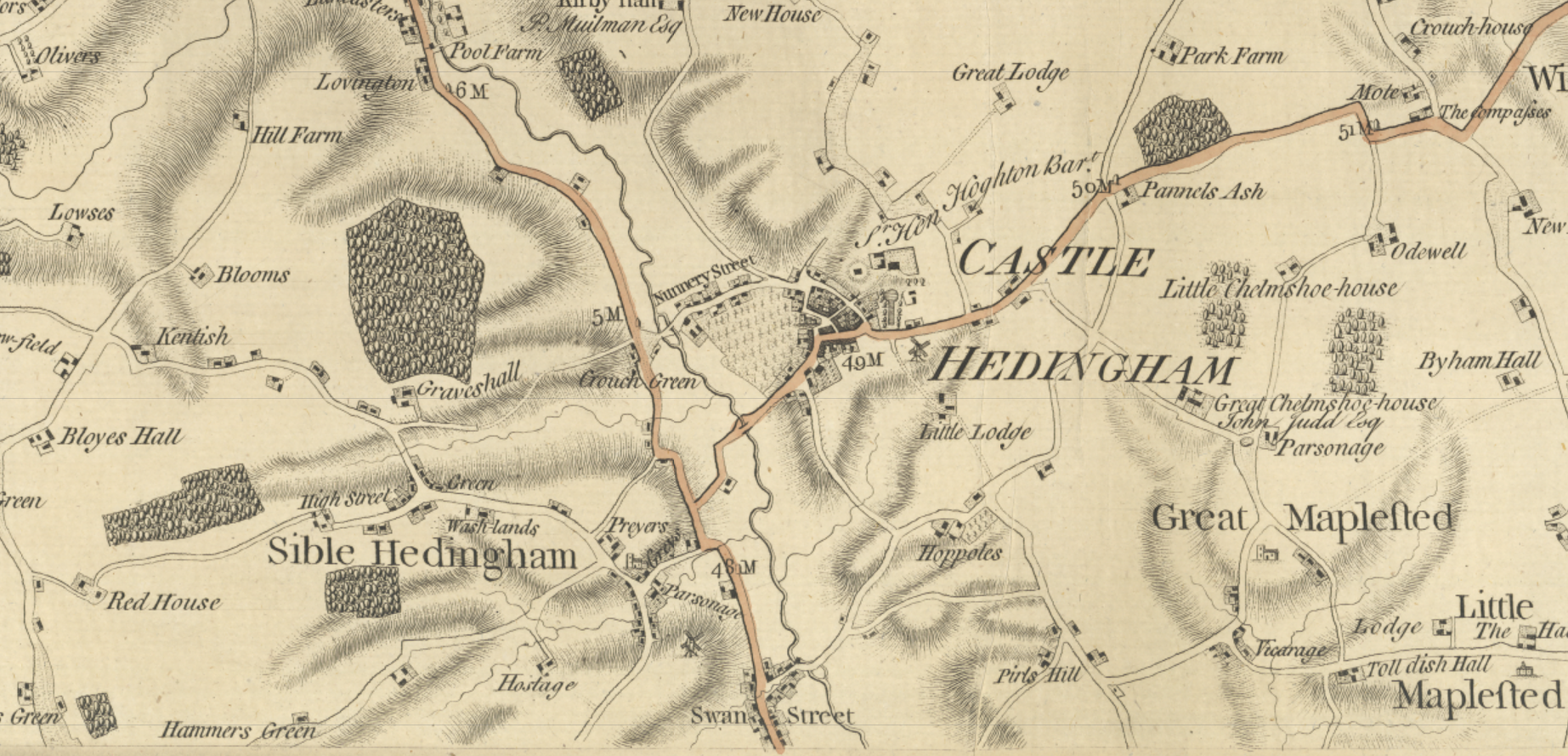Sible Hedingham
Sible Hedingham is South of Castle Hedingham and West of Belchamp Walter.

Thomas Wright's account:
This parish is bounded, on the south and south-west, by Gosfield and Weathersfield ; and , on the north and north-west, by Great Yeldham and Toppesfield. It is three miles distant from Halstead, seven from Braintree, and forty-eight from London. The soil in general is distinguished by the same characteristics as that of the greater part of the hundred: it consists partly of light loams on gravel, with some good strong loam, two feet deep, of various degrees of tenacity. A large proportion of the best Essex hops are grown here. The village is very pleasantly situated , near the river Colne; it contains numerous shops, and many good houses, and the population, which is considerable, is supported by various occupations and trades, dependant on agricultural productions, and by supplying the neighbourhood with articles of necessary consumption. There are six manors in this parish. The manor of Preyers, also called the manor of Sible Hedingham, was in the possession of seventeen freemen previous to the Conquest, and, at the general survey, was one of the six lordships which had been given to Roger Bigot, earl of Norfolk, whose second daughter, Adeliza, in the reign of King John, conveyed it, in marriage, to Alberic de Vere, the second earl of Oxford, in whose family it continued till the time of Queen Elizabeth. * Robert de Preyers + held this estate under the De Veres, in the time of King Henry the Third, and the manor seems to have received the name of this knightly family .

To be continued....... pulling text from Thomas Wright
Sir Thomas , * the son of Robert de Preyers , married Anne , daughter and heiress of CHAP . V. Hugh de Essex , junior , a descendant of Suene de Essex , baron of Raleigh ; his only daughter and heiress was Margaret , married to Robert de Bourchier , lord chancellor of England in the reign of King Edward the Third ; and it remained in the possession of the Bourchier family till it became extinct , in the time of King Henry the Eighth . † Edward de Vere , earl of Oxford , had for his second lady , Elizabeth , daughter of Thomas Trentham , Esq . of Roucester , in Staffordshire , and settled this estate upon her and her offspring male ; remainder to her brother , Francis Trentham , Esq . to whom it soon afterwards descended ; and his grand - daughter conveyed it in marriage to Brian Cockayne , viscount Cullen , of Ireland ; on whose decease , in 1713 , this manor was sold , with Boure Hall and Greys , to Robert , William , and Samuel Ashurst , Esquires , from whose descendants it passed by marriage , to Sir . Henry Houghton , Bart . of Houghton Tower , in Lancashire , and of the Castle , in Castle Hedingham . Boure Hall is appendant to the manor of Preyers , though it is sometimes men- Boure tioned in records as distinct and independent . The mansion , of which there are no remains , was at some distance from Preyers , in a field which retains its name . Preyers and Boure Hall having been given to the progenitors of the Bigot family , earls mar- shal , they were consequently appendages of that office in succeeding ages ; and it is stated in the records , that Thomas de Vere , earl of Oxford , who died in 1371 , held the manor of Hedingham Sible of the earl marshal , by knight's service . Hall . The manor of Greys retains this name from Sir Thomas Grey , to whom it formerly Greys . belonged ; the mansion was near the church - yard . This estate was in the possession of Godwin , a freeman , in the reign of King Edward the Confessor ; and , after the Conquest , was given to Roger de Ramys , or Raynes , whose under tenant was Ga- renger , a freeman . Robert de Raynes was a descendant of Roger , and held this estate as part of his barony , which continued in his family till the reign of King Henry the Third ; when Richard de Raynes , on his decease , left three daughters , Alice , Amice , and Joan ; the eldest of whom , by marriage , conveyed this estate to Sir Thomas Grey , who , on his death , in the year 1322 , held , with his wife Alice , as of her inheritance , lands here of the exact amount of this estate , which had been , at an early period , considerably more extensive , being described in Domesday - book , as in- cluding a farm called Peppers , on Fory Green , extending towards Weathersfield . It cannot be ascertained at what precise time it passed from the Grey family . Greys was afterwards in the possession of the Vere family , till it was , with their other